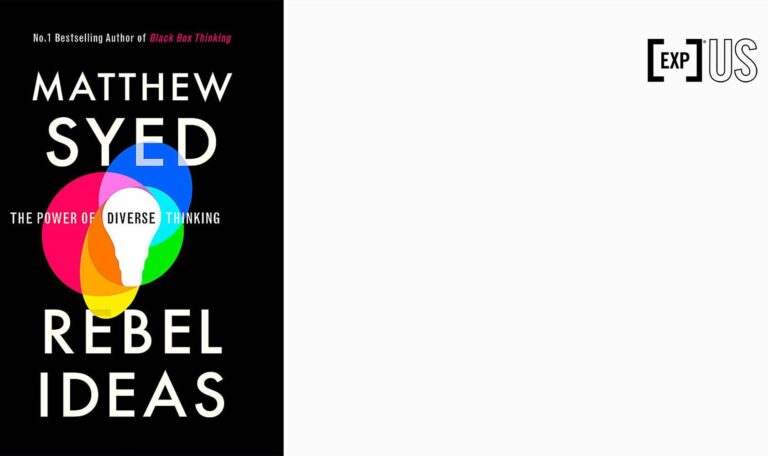How the presence of diversity in teams and its contrasts can enhance collective intelligence and help create a more open environment for innovation to happen in organizations
Central ideas:
1 – It is important to constitute the science of diversity. It becomes necessary to coin concepts that explain why homogeneous institutions tend to fail, often without realizing why, but also why diverse teams can become more than the sum of their parts.
2- The diversity of mentalities was important in England’s deciphering of the so-called Enigma, the secret code of the Nazi armed forces, in World War II. Together with mathematicians and other scientists, an expert in crossword puzzles was essential in deciphering the Enigma and the final course of the war.
3 – According to studies by Leigh Thompson, when one or two people dominate an environment, they suppress the ideas of the other team members. If the dominant person is the leader, things get even worse, and people copy his decisions. Rebellious ideas are not expressed.
4 – The balance between incremental and recombinant innovation started to fall drastically. Recombination has become the dominant force for change, not only in science but in industry, technology, and beyond.
5- There is a worldwide over-standardization. We standardize education, labor agreements, policies, medicine, and even psychological theories. All, in different ways, fail to consider diversity. They treat people under a mythical average, not as individuals.
About the author:
Matthew Syed is a highly acclaimed author and speaker in the area of high performance. In addition to Rebel Ideas, he has written books such as Bounce, Black Box Thinking, and others. A table tennis aficionado, he participated in the Barcelona Olympics at the end of his first year at Balliol College, Oxford University

1 – Collective blindness
Diversity was further reduced after the end of the Cold War. In Legacy from the Ashes, by Pulitzer Prize-winning reporter Tim Weiner, there is a quote attributed to the CIA director of the early 1990s, Robert Gates, about the agency becoming less willing to employ “different people, eccentric people, people who don’t look good in a suit and tie, people who don’t align themselves with others. The tests we apply, psychological and everything, make it difficult for peculiar people to come into the agency.”
This idea that excellence and diversity are mutually exclusive has a long tradition. In the US, it formed the basis of a seminal argument by Justice Antonin Scalia for the Supreme Court. You can choose diversity, he argued, or be “extraordinary.” If a diverse workforce or student population, or whatever, arises organically as you pursue excellence, that’s one thing. But privileging diversity over excellence is different. And it is likely to undermine the very goals that inspire it.
Part of the reluctance to recruit ethnic minorities was fear of counterintelligence, but the issue was deeper. Those who clamored for broader recruitment were silenced by the dilution of excellence. The CIA must be the brightest and the best! Defense is too important to allow diversity to trump capability! As one critic put it, “Putting political correctness above security was not an acceptable option.”
What they failed to realize was that this was a fallacious and dangerous dichotomy.
Cognitive diversity was not that important a few hundred years ago, because the problems we faced tended to be linear, simple, dissociable, or all three. A physicist who accurately predicted the position of the moon didn’t need a different opinion to help her do her job. She has already hit the nail on the head. Any other opinion is fallacious. This goes back to our common-sense intuition. To think differently is a distraction. With complex problems, however, this logic is flawed. Groups with diverse views have a huge, often decisive advantage.
The CIA could have allocated more resources to watch Al-Qaeda. It could have tried to infiltrate. But it was incapable of understanding the urgency. It did not adopt more resources because it did not perceive the threat. It did not seek to penetrate al-Qaeda because it was unaware of the gap in its analysis. The problem was not (just) the inability to connect the dots in the fall of 2001, but a failure in the entire intelligence cycle. Collaboration should be about broadening and deepening understanding. The homogeneity of the CIA created a vast collective blind spot.
The CIA was insightful from an individual standpoint, but from the collective, blind. And it is in the crosshairs of this paradox that we glimpse the imperative of diversity.

2 – Rebels versus clones
Diverse groups express radically different properties. It was fascinating to see how people who were not soccer experts noticed some of the underlying weaknesses in the methods of selection and training, bringing a new perspective to media relations, or the preparation for a penalty shootout. Rebellious ideas were often rejected. The exchanges were fertile. And they almost always led to divergent thinking and more sophisticated solutions.
The group is by no means perfect, I emphasize. There are many gaps in our understanding. And there were times when the discussion did not flow well. Any group benefits from changes in its methods and operations. Intelligence always needs to evolve.
But it was this experience, above all, that made me think about the theme of this book. It became clear that diversity has an underestimated power, something I had not yet realized. However, I also found myself wanting to clarify the how and the why. Experiencing the dynamics of diversity is one thing; knowing how to make it work in different contexts and sectors – how to optimize it – is another.
And so it was important to constitute a science of diversity. I wanted to coin concepts that would explain why homogeneous institutions tend to fail, often without realizing why, but also why diverse teams can become more than the sum of their parts. Concepts capable of explaining why diversity is emerging in all branches of academia and starting to dominate the strategies of top institutions, in business, sports, and more.
A typical case of a solution calibrated on diversity was the mission to find, to discover the Enigma machine of Nazi Germany. Bletchley Park is the name of the estate in rural Buckinghamshire, 50 miles northwest of London, where a team of men and women gathered to work on the most secretive of missions. The Enigma machine was a cryptographic device used by Nazi Germany in all branches of its armed forces. The Bletchley Park group was recruited by British intelligence to, among other things, unravel Enigma. Among those recruited was Stanley Sedgewick, an employee of a firm of accountants in the town. He was good at solving crossword puzzles, mainly published by the Daily Telegraph.
The man in charge of the Bletchley Park operation was Alistair Dennison. In 1939, he hired Alan Turing, then a colleague of Dennison’s at King’s College, Cambridge, considered one of the greatest mathematicians of the 20th century, and Peter Twint, also a mathematician, from Oxford. Included in the mission were Leonard Foster, a scholar of Germany and the Renaissance; Norman Jopson, professor of comparative philology; Hugh Last, a historian; and A. H. Campbell, a legal philosopher.
The desire to recruit crossword enthusiasts, such as Sedgewik, arose from the quest to get ideas from across the problem space. It seemed odd that the Bletchley Park recruiters would observe the Daily Telegraph’s crossword competition. But they were acting from a holistic perspective. They had the genius insight that crosswords share critical characteristics with cryptography.
When Sedgewick arrived at Bletchley Park, he was allocated to focus on intercepting weather codes. They were crucial to the Royal Air Force Bomber Command, helping them make better-informed operational decisions, but they had an additional purpose. They served as guinea pigs for the Enigma machine used by the German Navy. Breaking those codes had priceless repercussions, playing a key role in the Battle of the Atlantic. It allowed U.S. convoys to evade the waiting German U-boats, creating a link between the United States and Europe that allowed Britain to benefit from crucial merchant supplies to keep fighting.
In other words, breaking the Enigma code depended on breaking an earlier code: that of diversity. Let’s say that the Enigma operation hired only mathematicians, bright people of the same class and background.

3 – Constructive Dissidence
A person has a single pair of eyes. A team has many. So the question we ask is: how do we combine useful information and perspectives? For diversity to work its magic, different perspectives and judgments must be communicated. It is not good to withhold useful information.
There is also the question of who makes the final decision after the various perspectives are expressed. If there are conflicting opinions, who decides? If there are different ideas, do we merge them or select one over the others? In this chapter, we will move from the conceptual foundations of diversity to practical implementation.
A smart study by the Rotterdam Business School analyzed more than 300 real projects dating from before 1972 and found that projects led by junior managers were more likely to succeed than those with a senior in charge. In light of the study, the fact seems surprising. How could a team perform better when deprived of the presence of one of its more experienced members?
The reason is that such leadership has a sociological price when it embraces a dominance dynamic. The knowledge lost by the group when the senior manager is removed from the project is more than compensated for by the additional knowledge expressed by the team in his absence. As Ballazs Szatmari, lead author of the study, stated, “The surprising thing in our findings is that high-status project leaders fail more often. I believe this occurs not despite the unconditional support they receive, but because of it.”
The logic of meetings is notorious. Many brains are more effective than one – as long as they are diverse. In the past two decades, the time spent by managers and employees on collaborative activities has increased by more than 50%. But here we face a troubling, little-discussed truth. Countless studies reveal the same result: meetings are catastrophically inefficient. Just as Leigh Thompson, an academic at the Kellog School of Management told me, “Meetings predict more terrible outcomes than smoking causes cancer.”
Thompson is a professor of management and conflict resolution in organizations and has spent her life studying group judgments. As she conducted her research, she soon realized the dynamics of domination. When one or two people dominate, they suppress the ideas of other team members, particularly introverts. If the dominant person is a leader, things get even worse, and people copy his or her decisions. The rebellious ideas that exist within the group are not expressed. She says: “The evidence suggests that in a group of four people, two are responsible for 62% of what was said, and in a group of six people, three are responsible for 70% of the talking. It gets worse as the size of the group increases.” In fact, this is so common that it has earned a name: “the problem of unequal communication.”
Teams need a leader; otherwise, there is a risk of conflict and indecision. And yet, the leader will only make wise choices if he or she has access to the diverse group views. How, then, can an organization have hierarchy and information sharing, determination,, and diversity? This is a question that has dominated management textbooks for decades, and the approach is usually to position hierarchy and diversity in inherent conflict. The idea is to change the hierarchical gradient so that you have a little dominance and a little diversity.

4 – Innovation
Innovation experts distinguish it into two types. On the one hand, there are the direct, predictable steps that delve deeper into a given problem or specialization. Think of James Dyson patiently improving his vacuum cleaner design, learning more about separating dust from air by adjusting the dimensions of his famous cyclone. With each new prototype, he learned more about the efficiency of separation. With each new step, he gained a deeper understanding of this small segment of science. This kind of innovation is called incremental. It denotes the idea of deepening knowledge within well-defined boundaries.
The other type of innovation is embodied in the two examples we have just discussed. It is called recombinant innovation. You take two ideas, from different, previously unrelated fields, and merge them. A wheel with a suitcase. A new form of energy generation with a reformed manufacturing process. The recombination is usually drastic because it bridges domains or destroys silos, opening up new possibilities.
In recent years something has happened that has escaped the knowledge of many people; indeed, of many scientists. The balance between incremental and recombinant innovation has begun to fall dramatically. Recombination has become the dominant force of change, not only in science, but in industry, technology, and beyond.
To get a sense of this dominance, consider a study led by Brian Uzzi, a Kellog School of Management professor that analyzed 17.9 million publications in 8,700 journals on the Web of Science, the world’s largest repository of scientific knowledge. That’s virtually all articles written in the last 70 years. He was looking for patterns. What creates great science? Where are the great ideas?
What did he find? The papers with the greatest impact were those with what researchers called “atypical combinations of subjects”; that is, papers that cut across traditional boundaries. These papers mixed, say, physics and computer science, anthropology and network theory, or sociology and evolutionary biology. This is the scientific equivalent of “ideas reproduce themselves. These articles broke down the conceptual walls between subjects and silos of thought, creating new ideas and possibilities.
Take a look at the following list of names: Estée Lauder, Henry Ford, Elon Musk, Walt Disney, and Sergey Brin. Do you notice what they have in common? They look like a list of famous entrepreneurs, people who have impacted American society. But dig a little deeper and you’ll notice that they share a pattern with dozens of others, including Jerry Yang, Arianna Huffington, and Peter Thiel, each of whom helped shape the modern US economy. The link between these people? They are all immigrants or daughters of immigrants.
Immigrants have another advantage, inextricably linked to the notion of recombination. They have experience in two cultures, so they have greater scope for bringing ideas together. They act as bridges and facilitators for the “sex of ideas.” If the outside perspective confers the ability to question the status quo, the diversity of experience provides recombinant responses.

5 – Echo chambers
The great diversity of broad social networks can potentially produce paradoxical effects on local networks. This holds for the digital world as well as the social world. A cosmopolitan university like the University of Kansas can lead to homogeneous friendship groups. An occasion purposefully created to encourage people to interact leads to refined variety.
These ideas help to understand one of the defining paradoxes of the modern age: ideological echo chambers. For all its promise of diversity and interconnectedness, the Internet has been characterized by a new breed of homogeneous groups, linked not by the logic of kin or nomadic tribes, but by ideological refinement. This is a completely digital incarnation of the insular dynamics of the Neolithic era, with information circulating within groups rather than between them. In many cases, echo chambers are of no concern. If you are interested in fashion, you want to participate in a forum in which you can talk to other like-minded people. It would hurt your satisfaction if people kept posting about soccer, architecture, or fitness. In these forums, diversity is not only redundant but annoying.
However, when we seek to inform ourselves about complex subjects, such as politics, the echo chambers distort. By receiving news from Facebook and other platforms, where friends share cultural and political trends, people are exposed to people who agree with them and the evidence that reinforces their views and are less exposed to opposing perspectives. The potential of refined variation is amplified by a subtle phenomenon: intellectual bubbles.
It is this epistemic vulnerability that echo chambers exploit. By systematically undermining the confidence of those in the group in alternative views, by defaming those who offer different ideas and perspectives, they introduce a filter that distorts the very process of belief formation. Alternative views are dismissed at first contact, not after consideration. Facts are rejected, even when they are presented. Perspectives and evidence are repelled like equal poles of a magnet. Nguyen states, “Echo chambers operate as a kind of social parasite on our vulnerability…An information bubble is when you don’t hear people on the other side. An echo chamber happens when you don’t trust people on the other side.”
Many ancient Greek philosophers, including Socrates himself, argued that the proper functioning of a democracy is inextricably connected to the quality of its deliberations. Only by testing ideas and examining evidence do we arrive at reasoned decisions. This is the lesson that emerges also from our analysis of the science of diversity, as well as of the formal theories that probe the conditions under which democracy leads to wise outcomes. And this is exactly why Socrates believed citizens needed to detect and punish fallacious reasoning.

6 – Beyond the average
If it wasn’t engineering or skill [behind many occurrences in the U.S. Air Force. The late 1940s], what else could it be? At the heart of this mystery was a Harvard alumnus who specialized in physical anthropology. The awe-inspiring Gilbert S. Daniels was not a conventional aviator: a quiet, soft-spoken, methodical, scientific man, he included gardening among his hobbies. Daniels had a hunch. He believed that the problem lay not in engineering or pilot decisions, but in cockpit design.
Some members of the Air Force pondered whether pilots had grown fat since 1926, making it difficult to operate the controls. Could that be the explanation for all the failures? Daniels had a different guess. He stipulated that the problem was not based on the weight of the airmen, but on what they had defined as the “average airman,” which was imprecise. Perhaps there was no average aviator.
In 1952, Daniels had the opportunity to test his intent. He led a project at Wright-Patterson Air Force Base that aimed to measure the dimensions of pilots. Daniels set about the task, carefully tabulating 4,063 pilots into 140 size classifications. They included “thumb length, crotch height, and distance from eye to ear.” He then averaged the ten dimensions he considered most important for cabin design. In other words, he was tabulating the dimensions of the average pilot.
But then what happened? How many pilots were in the middle range between the ten dimensions? None. Out of a cut-off of more than 4,000, not one of them was average. Daniels’ hunch was emphatically confirmed. The problem was not that the average pilot had grown fat since 1926. The problem was that there was no average pilot.
Daniels’ work led to an important realization. A standardized cockpit for the average pilot may seem logical, even scientific, but it is fraught with latent dangers. The standardized cockpit was the root cause of the alarming incident rate, causing several occurrences. And it forced the Air Force to think about the design differently. Instead of requiring the pilot to fit into a standard cockpit, which hardly suited anyone, they redesigned it to fit the diversity of pilots.
The standardization of the U.S. Air Force cockpit is not only a danger but a metaphor. This is just one example of worldwide standardization. We standardize education, labor agreements, politics, medicine, and even psychological theories. All, in different ways, fail to consider human diversity. They treat all people as manifestations of a mythical average, rather than as individuals. This brings us back to the point at the beginning of this chapter about how this failure can make us forget human diversity and squander its benefits. We are all different from each other. We have different physical dimensions, but also different cognitive traits, strengths, and weaknesses, experiences, and interests. This is one of the most wonderful things about our species.
In a 2014 Google experiment, a team of psychologists conducted a small workshop for sales and administration employees. The workshop encouraged the professionals to think of their jobs not as parameters, as inflexible cockpits, but as adjustable designs.
What happened? Those who attended the workshop were rated by managers and co-workers as happier and better performing and were 70% more likely to get a promotion or switch to a preferred job, compared to a control group.

7 – The big picture
Today, the main focus remains individualistic. We are concerned with helping people become smarter, more discerning, and better able to protect themselves against prejudice. We note that the excellent work of artists like Gary Klein and Daniel Kahneman is written from this point of view. And while this perspective is important, we must never allow it to obscure the holistic perspective.
The organizing concepts presented in this book are holistic: the collective brain. The wisdom of crowds. Psychological security. Recombinant innovation. Network theory. The dangers of the refined assortment. The content of these concepts emerges not from the part, but the whole. This is crucial at a time when our most pressing problems are too complex for individuals to solve on their own. We live in an age when collective intelligence is increasingly important and indispensable.
Our species is, in this sense, built on diversity. Our species is unique in the way that different ideas, experiences, discoveries, and random recombinations sweep through our connection networks, building the collective brain, expanding collective intelligence, and altering the trajectory of natural selection. It is the diversity of these ideas that makes us intelligent. Stripped of the accumulated pool of ideas, the naked human brain is much less impressive.
Another way in which top companies are harnessing diversity is with the use of “shadow boards.” They consist of young people who advise executives on important decisions and strategies, thus mitigating the shortcomings associated with age. After all, each of us grew up at a certain time and absorbed a specific cultural and intellectual paradigm. This influences how we think in so many ways that we can become unaware of it.
Shadow boards usually consist of a group with the most capable young people from across the organization, who regularly contribute to high-level decision-making. This allows executives to “leverage the ideas” of the younger groups and diversify the perspectives to which they are exposed. This, in turn, generates a greater flow of rebellious ideas.
Conclusion
Only when we begin to absorb the truths of diversity science does our perspective begin to change. We begin to see intelligence not just as a function of the intellectual brilliance of individuals, but of their collective diversity. We see that innovation is not merely about the ideas of particular people, but about the networks that enable their recombination. And we see that the success of humanity has less to do with individual brains and more to do with the emergent properties of the collective brain.
FACTSHEET

Title: Rebel Ideas – The power of thinking differently
Author: Matthew Syed
Images: Freepik, Unsplash, and Stock
Review: Rogério H. Jonck
![[Experience Club] US [Experience Club] US](https://experienceclubus.com/wp-content/uploads/2021/03/laksdh.png)










![[Experience Club] US [Experience Club] US](https://experienceclubus.com/wp-content/uploads/2021/03/logos_EXP_US-3.png)







